Amazon is one of the most famous marketplaces and the third-largest company in the world based on revenue. Amazon lists nearly 2 million SMBs as third-party sellers, so it’s no wonder that new users feel intimidated by such high competition. Some people think it is impossible to make money selling stuff on Amazon and beat experienced sellers. Is it really true? Let us figure it out together.

Is Selling on Amazon Profitable?
Absolutely, Yes! The numbers can tell you the most about the profitability of any business. Consider the main indicators of profitability.
Revenue of the marketplace has grown by 840% over the past 10 years, reaching $514 billions in 2022. (Source: Statista)
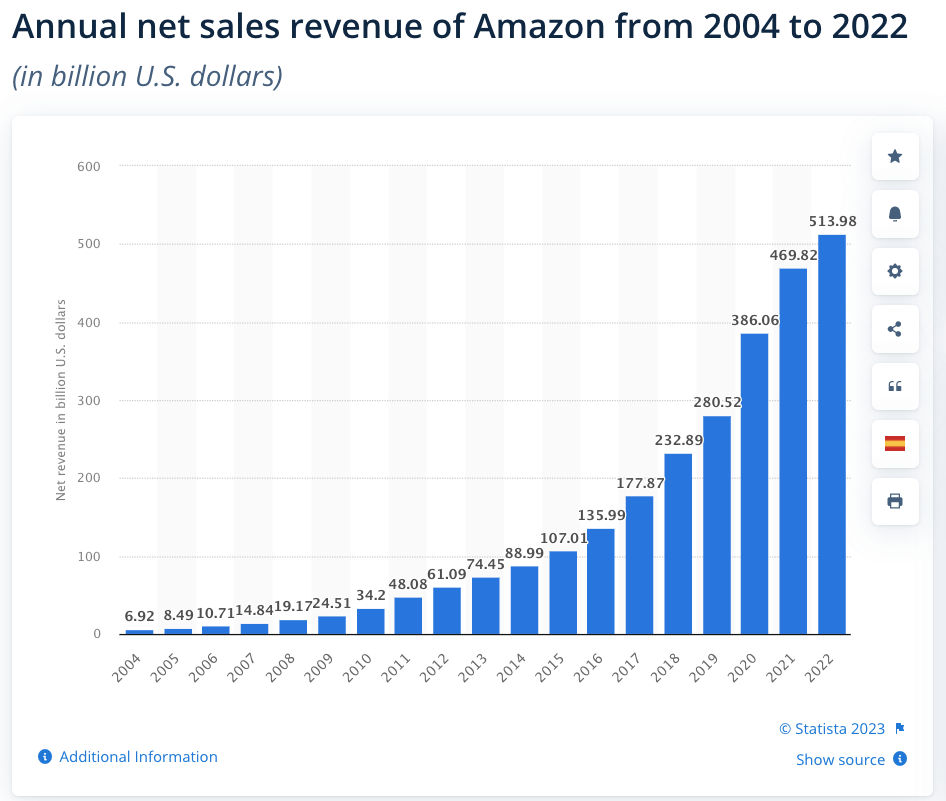
According to Jungle Scout:
The average income from selling on Amazon in 2021 was anywhere between $12,000 to $300,000 a year.
Half of Amazon sellers make between $1000 and $25,000 each month. In 2022, the average annual sales of new Amazon sellers was more than $42,000 per year or $3,511 per month.
This year, 89% of Amazon sellers reported being profitable. Despite facing new challenges from rising costs, 37% of sellers reported an increase in profit.
What Are the Profit Margins on Amazon Sales?
It’s not easy to start a business. Therefore, many offline stores make paltry profits for the first few years and may run at a loss in some months. At the same time, Amazon SMB sellers show healthy profit margins.
Note, the margin is not constant. It depends on many factors and can fluctuate from month to month. Factors that affect the profit margin include:
Product category
Item
Cost of goods
Demand
Price Strategy
Costs
According to statistics, 65% of Amazon sellers earn profit margins greater than 10%, and nearly one-fifth of Amazon sellers (19%) earn profit margins of at least 25%. A small percentage of sellers (8%) do not make a profit, and another 8% are unsure about their profit margins. Source: Jungle Scout
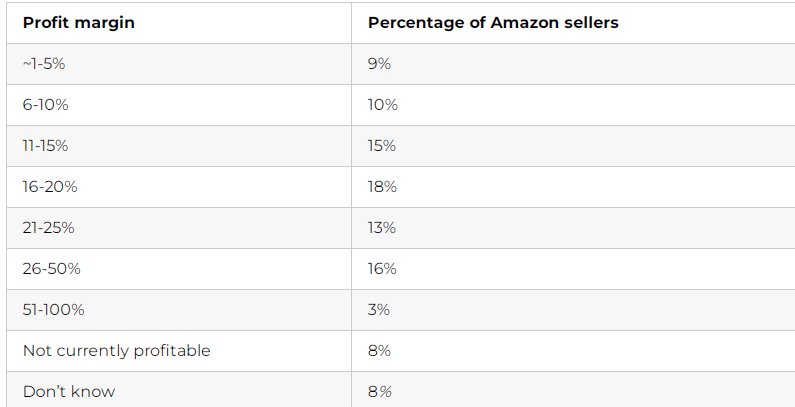
On average, you can expect to make 16-20% profit from Amazon business. That is significantly more than most traditional stores. Additionally, if you take it seriously, the risks of failure are much lower. Furthermore, 64% of Amazon sellers become profitable within their first year of sales.
To make a profitable business, you should aim to profit margins of at least 10%. If you want to be successful selling on Amazon, use the Profit Calculator to figure out all of your income and expenses. Estimate the profitability of your products by taking into account all aspects.
Read about secrets to achieving healthy margins for Amazon sellers.
Pros and Cons of Selling on Amazon
The Amazon marketplace has become one of the most effective and easy-to-use online marketplaces for businesses. It offers a variety of features and benefits that can help sellers generate sales, reach more customers, and improve operational efficiency. However, like any business venture, selling with Amazon has pros and cons.
PROS
easy to start selling
Selling on Amazon is a great way to start your journey of selling online. It’s easy to launch and requires minimal setup time and initial costs compared to traditional stores. Amazon offers entrepreneurs a ready-made customer base, enabling them to swiftly showcase their products to potential customers. The rest is up to you!
large audience
Selling on Amazon is an excellent option for businesses to attract new customers and boost sales. With over 310 million active buyers, Amazon offers the largest online marketplace to date. Using the platform, you can increase the reach of your loyal audience, and visibility and push your sales to a new stage.
hassle-free business with FBA
One great way to generate income is through an Amazon FBA business. With Amazon`s world-class fulfillment services and a network of warehouses, you don’t have to worry about stocking, shipping, or managing inventory for your products.
Amazon will take over these duties. This means you can focus on growing your business without the hassle of storing inventory and processing orders. Moreover, if you use Amazon’s fulfillment centers to sell your products, they will receive Prime status and become eligible for the Buy Box with most of traffic.
amazon prime members
Amazon sellers using FBA automatically receive the Prime badge and have access to 160 million loyal Prime members in the U.S. and 200 million members worldwide that order exclusively from Prime sellers. Because most customers buy Prime to get free and fast two-day delivery. The average Prime member spends $1,400 a year, while non-members spend less than half that amount – only $600. Sounds good!
CONS
High competition
One of the major cons of selling on Amazon is high competition. With millions of products available, it can be hard to differentiate your items from those of other sellers. Thus, price wars and other tactics are often used to gain a competitive advantage.
FBA fees
Another potential downside of selling on Amazon is the FBA fees. Fulfillment by Amazon can be expensive due to various fees associated with it, such as storage fees, fulfillment fees, service fees, and others.
While these costs are lower than those of setting up your own fulfillment process, they can still add up over time. Additionally, Amazon charges a referral fee for each sale you make in the marketplace, usually between 8-15%.
High return rates
Although Amazon provides a ready-made customer base, a loyal policy towards product returns incurs additional costs for sellers. The high return rate associated with Amazon sales can hurt your business if you are not ready for it.
Strict policies
Amazon is known for having strict rules that must be followed when selling on the marketplace. Failure to follow these rules can lead to account suspension and loss of profits. So, it is important to research and understand Amazon’s rules before setting up your seller account.
Less control
Finally, you should be aware that when selling on Amazon, you will have less control over your listings and customer data than if you sold directly through your own website. Remember, the customers you are selling products to are Amazon customers.
Amazon has the final say regarding product description, pricing, and shipping options, which can limit how they market their products. Additionally, Amazon can change its policies and fees without prior notice.
Although this may result in a loss of profits or limited control over your listings, the benefits of using Amazon FBA far outweigh these downsides. With a well-thought-out strategy and understanding of the platform, you can use Amazon to build a profitable and successful business.
What Is the Fee for Selling on Amazon?
When you sell something on Amazon, there are some fees you have to pay. Some of these fees are for all sellers, and some are only for certain kinds of sellers.
There are also additional fees if you sell extra large items, books, DVDs, CDs, or blue rays. We will talk about what fees all sellers must pay, regardless of their status and the type of product they sell.
Fees for Amazon sellers
If you sign up with Amazon as a seller, the first fee you will have to pay is the Amazon seller account fee. The fee you have to pay depends on what you are selling, how much, and which Amazon selling plan you choose.
Using an Individual Selling Plan, you will pay only $0.99 per item sold, plus other selling fees that vary by category.
If you sell more than 40 products in a month, choose the Professional Selling Plan. Professional sellers pay a monthly subscription fee of $39.99, plus referral and variable closing fees by category or item type. The Professional plan includes some additional features such as customized shipping rates, reports and business tools, multi-channel fulfillment, and Seller Fulfilled Prime.
Referral fees
When you sell something on Amazon, you have to give some of the money you earn to Amazon. This is called a referral fee. The amount varies depending on the type of product being sold. Here is a list of all referral fees for different items:
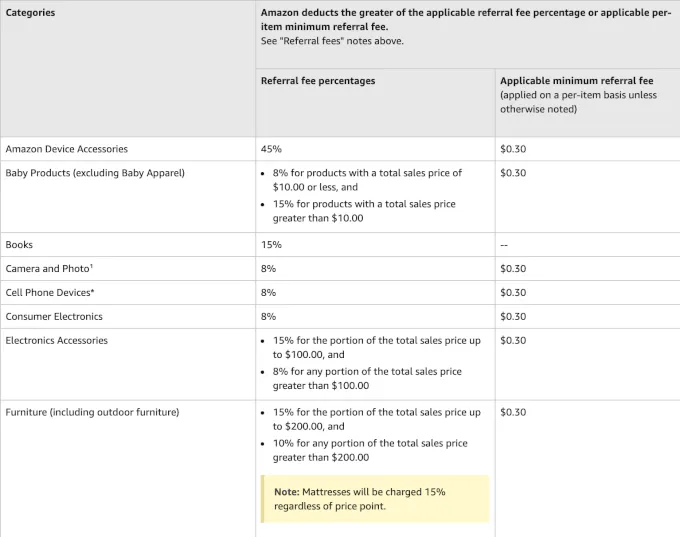
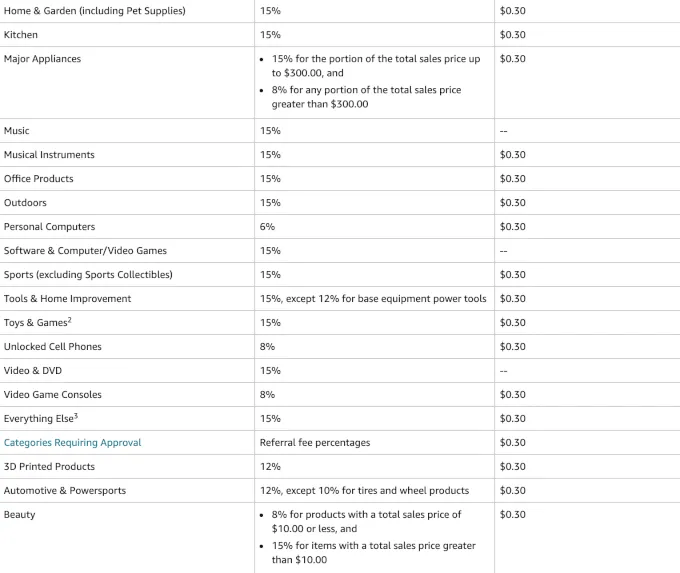
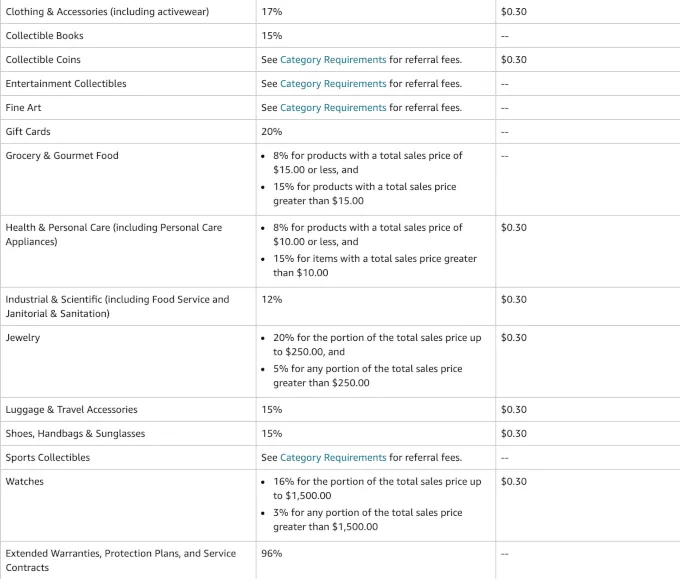
Refund administration fees
If you need to refund a customer their money, Amazon will give you your referral fee back. But they will charge a processing fee of either $5 or 20% of the referral fee. The lower amount of the two is what they will charge you.
Amazon FBA fees
There are two main ways you can sell on Amazon. You can store all your inventory and ship directly to the customers when they order one of your items. This called FBM. Or you can sell as an Amazon FBA seller. This means that Amazon handles inventory management, shipping products, and all customer service.
Despite the rather high Amazon FBA fees, 89% of third-party Amazon sellers use Fulfillment by Amazon to manage their Amazon business. Let’s look at the FBA fees you’ll have to deal with.
Fulfillment fees
Amazon FBA fulfillment fee can be $2.50 or higher, depending on your product dimensions, weight, and category. When a sale is made, you will be charged for each unit to cover the costs of finding, packaging, and sending the product to the customer. Below you can see detailed figures for each category.
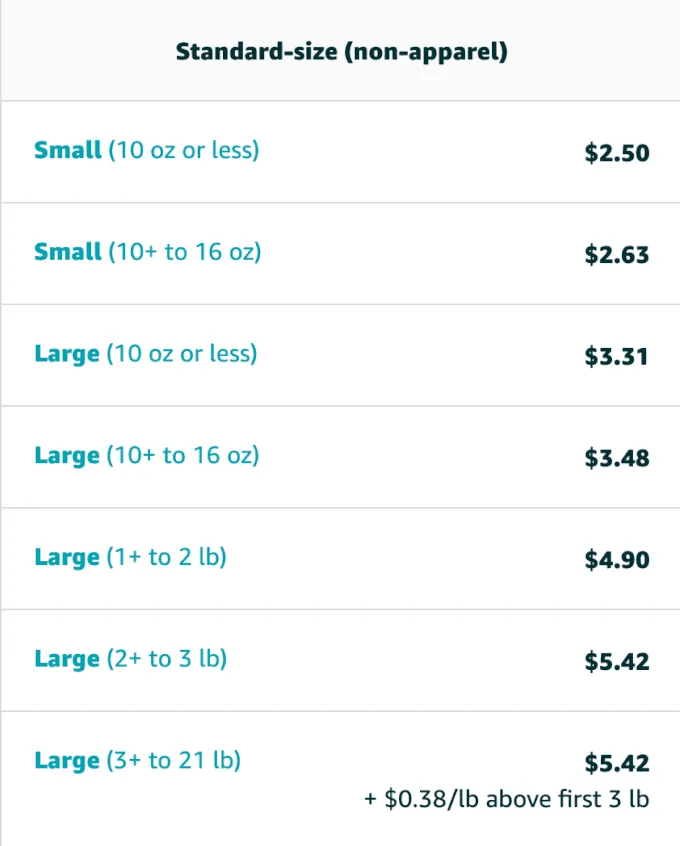
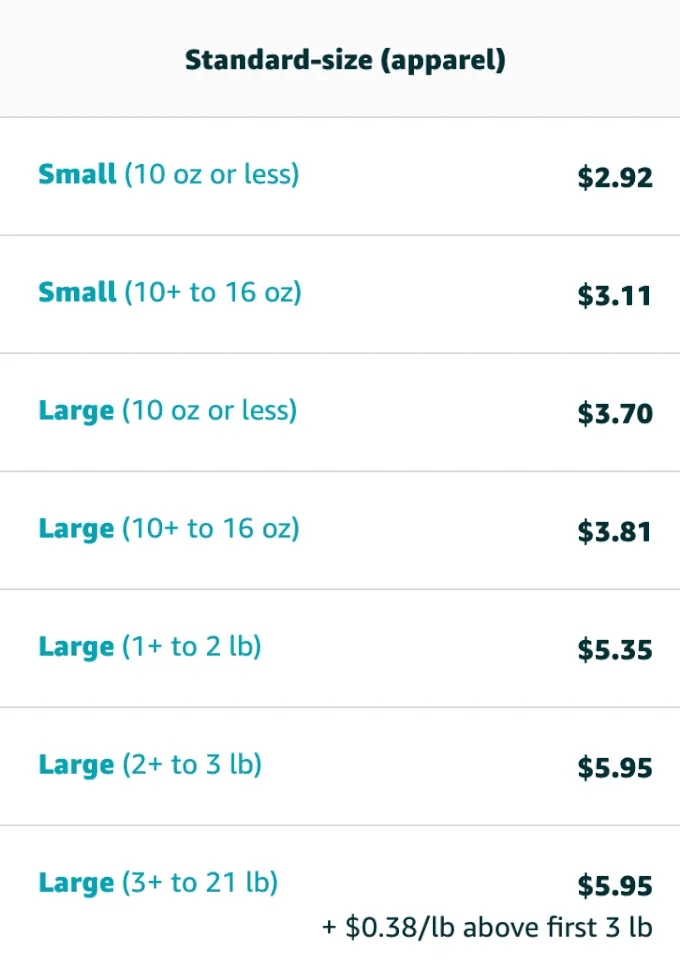
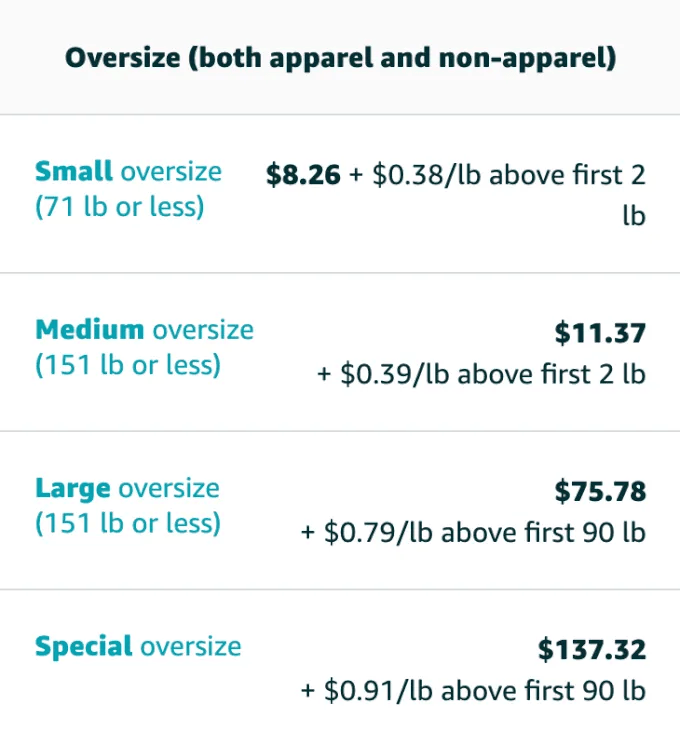
Storage Fees
Amazon charges monthly inventory storage fees based on the daily average volume (measured in cubic feet) of the space occupied by your inventory in Amazon’s fulfillment centers. The storage fees range from $0.75 to $2.40, and the cost of this service depends on the volume of your inventory and the season.

If you have not sold your items at the fulfillment center for over a year, you must pay monthly long term storage fees. You will be charged $6.90 per cubic foot or $0.15 per item, whichever is greater.
Removal and Disposal Fees
In addition to the fees associated with stocking and shipping products through Amazon FBA, there are also removal and disposal fees. These fees apply when a seller wants to remove items from Amazon’s inventory or dispose of them if they are no longer necessary or eligible for sale.
Returns Processing Fees
Returns fee applies when customers return items, and Amazon handles the reverse logistics process for you, such as refunding customers or restocking the returned item for sale. The amount charged by Amazon depends on the product category and size item that was returned.
Other Service Fees
Keep an eye on the quality of the merchandise you send to the Amazon warehouse centers. Amazon may charge extra fees if your packages don’t meet their requirements. This includes not having the correct labels and not storing products correctly.
Amazon FBM fees
If you are ready to decide all questions with storage items, shipping, and customer orders, choose FBM as the way to fulfill them. You will pay just a few fees, like Referral Fees, Seller Account Fees, and Service Fees.
FBM costs are usually more expensive than FBA costs since when you use FBM, you must pay for storage space, packing materials, and shipping of your products yourself.
To delve deeper into Amazon Fees, read the article Amazon FBA Fees Explained: What You Should Know In 2024.
What Can You Sell on Amazon?
When you’re thinking about selling on Amazon, a key question to ask is what products would be good to sell. Amazon offers an incredible variety of items. Whether you’re going to start selling physical goods or digital products, you have many available categories.
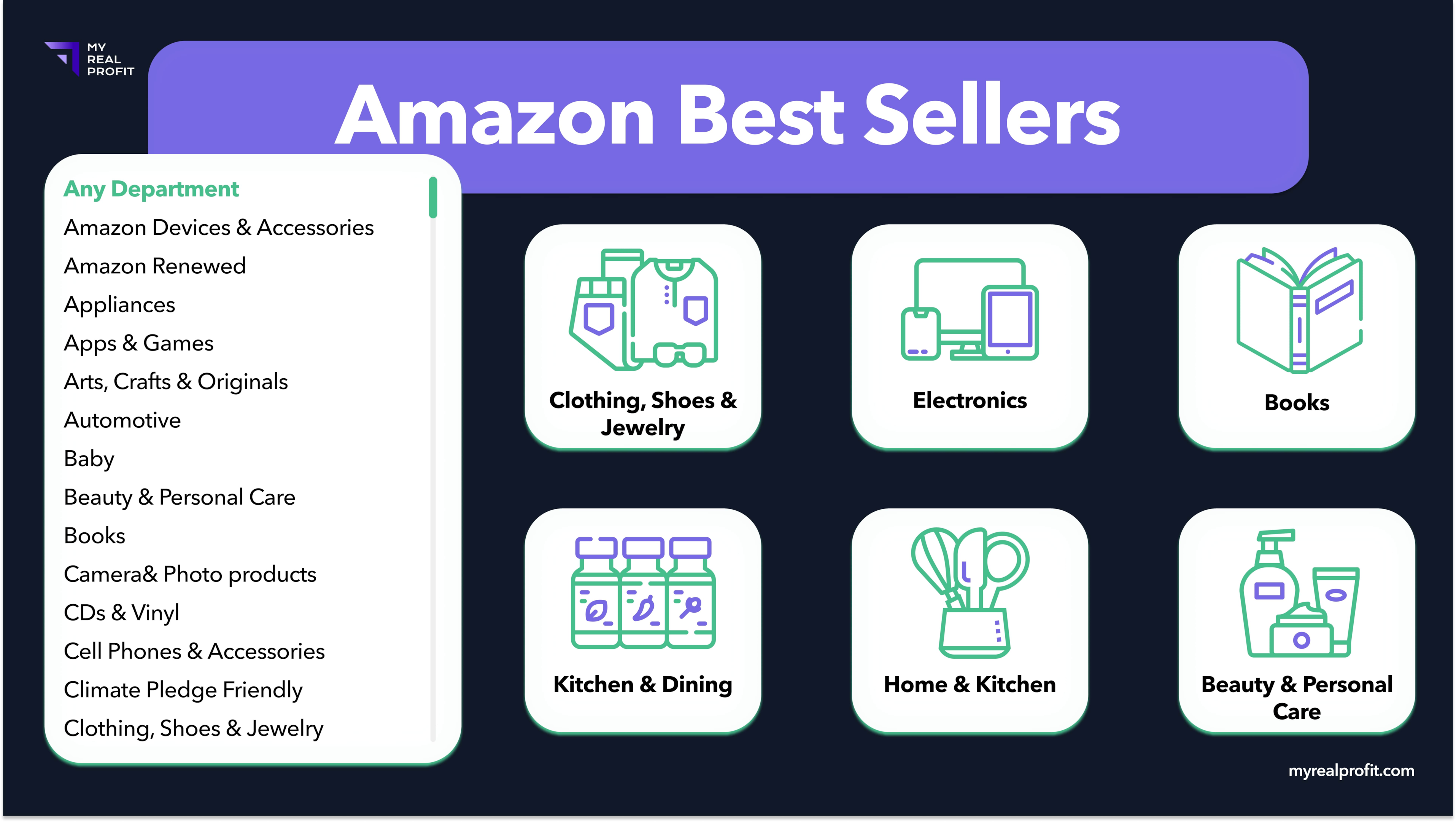
Depending on your budget, interests, and expertise, you can choose from millions of products to sell. Here are some of the most popular categories in 2023:
Electronics
Toys & Games
Camera & Photo
Pet Supplies
Home & Kitchen
Books
Clothing, Shoes & Jewelry
If you’re looking for a profitable niche on Amazon, check out our article Pros and Cons of the Most Profitable Categories on Amazon.
How Much Money Do You Need to Start a Successful Amazon Business?
The amount of funds needed to start a successful Amazon business depends on the type of products you plan to sell. It is possible to start a business with very little capital, but remember that the success of your business will depend greatly on how much effort and research you are willing to put in.
To start an online business, you need approximately $3,000 to $5,000 to get private-label products to sell on Amazon. The marketplace will take 35-50% of the money you make from your sales plus other related expenses.
If you want to sell products without big investments, try retail arbitrage or drop shipping. These are good options for people who do not have a lot of money.
How Long Does It Take to Start Selling on Amazon?
Preparing for sales on Amazon usually takes 2 to 6 month. It highly depends on supply chain as 80% of this time is product development and delivery from factory to FBA.
How Long Does It Take to Become Profitable on Amazon?
When it comes to selling on Amazon, the time needed to be profitable can vary. It depends on factors such as how well you market your products, demand for your items, and competition in the marketplace. Generally, with a well-planned roadmap and consistent effort, most businesses can achieve a steady stream of profits within six months up to a year.
Is Selling on Amazon Worth It?
Amazon is a tremendously lucrative channel for many sellers to make money, and you should use it. You need to know the rules and what could happen if you break them, especially if you are a new seller. Amazon could be a perfect opportunity to test things out, move your products quickly, and generate revenue that can be used to develop your own online store and brand.
Sales on Amazon bring in a significant profit if you are serious about market analysis, product selection, and promotional strategies. You can’t just make a product list and wait for a money to rain down. Successful sales and revenue depend entirely on your efforts and the right strategy that leads to high visibility. Therefore, relying on reliable data and up-to-date metrics of your performance on Amazon is critical.
Analytics software for Amazon sellers allows you to quickly collect and analyze actual data, see weaknesses, and make decisions based on up-to-date information about all your inventory, sales, revenue, and expenses. My Real Profit tracks 70+ fees and 30 metrics on an accrual basis in real-time to provide over 15 reports on your business’ performance. That means you will always have the latest info and don’t need to spend time filling out spreadsheets. You can instead focus on making your business better. Try the My Real Profit free for 14 days. We’ll show you the actual picture of your Amazon business.


